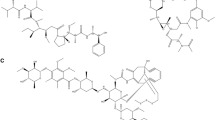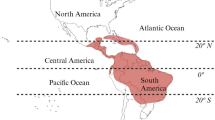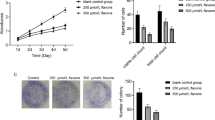Abstract
Lichens have exhibited numerous biological activities, including growth inhibition of tumor cells. This study evaluated the antiproliferative activity of hypostictic and salazinic acids against tumor cell lines (B16-F10, PC-03, MCF7, HT-29, HEP-G2, K562 and 786-0) by the SRB assay in vitro and antitumor activity in experimental murine melanoma in vivo. Activation of caspase-3 was quantified by flow cytometry. The murine experimental melanoma model B16-F10 was used in BALB/c mice for evaluation of antitumor activity. Hypostictic acid showed significant antiproliferative activity in K562 cells (GI50 2.20 μM), B16-F10 (GI50 13.78 μM) and 786-0 (GI50 14.24 μM), whereas salazinic acid was more active against K562 cells (GI50 64.36 μM), HT-29 (GI50 67.91 μM) and B16-F10 (GI5078.64 μM). Quantification of capase-3 revealed that the test compounds did not increase the expression of that enzyme. In the in vivo antitumor evaluation in B16-F10 melanoma, the isolated compounds inhibited tumor growth in relation to weight and volume. Hypostictic acid (16.7 mg/kg) inhibited 72% and salazinic acid 88% of tumor volume (p < 0.05). The results indicated that, both in the in vitro and in vivo models, the compounds evaluated showed antiproliferative and antitumor activities.
Article PDF
Similar content being viewed by others
Avoid common mistakes on your manuscript.
References
Bačkorová, M., Bačkor, M., Mikeš, J., Jendželovsky, R., Fedoročko, P., 2011. Variable responses of different human cancer cells to the lichen compounds parietin, atranorin, usnic acid and gyrophoric acid. Toxicol. In Vitro 25, 37–44.
Bézevin, C., Tomasi, S., Rouaud, I., Decros, J.-G., Boustie, J., 2004. Cytotoxic activity of compounds from the lichen - Cladonia convoluta. Planta Med. 70, 874–877.
Bisacchi, D., Benelli, R., Vanzetto, C., Ferrari, N., Tosetti, F., Albini, A., 2003. Anti-angiogenesis and angioprevention: mechanisms, problems and perspectives. Cancer Detect Prev. 27, 229–238.
Bishayee, A., Sethi, G., 2016. Bioactive natural products in cancer prevention and therapy: progress and promise. Semin. Cancer Biol. 40, 1–3.
Brisdelli, F., Perilli, M., Sellitri, D., Piovano, M., Garbarino, JA, Nicolett, M., Bozzi, A., Amicosante, G., Celenza, G., 2013. Cytotoxic activity and antioxidant capacity of purified lichen metabolites: an in vitro study. Phytother. Res. 27, 431–437.
Burlando, B., Ranzato, E., Volante, A., Appendino, G., Pollastro, F., Verotta, L., 2009. Antiproliferative effects on tumour cells and promotion of keratinocyte wound healing by different lichen compounds. Planta Med. 75, 607–613.
Carvalho, A.E., Barison, A., Honda, N.K., Ferreira, A.G., Maia, G., 2004. Two new compounds from the electroreduction of hypostictic acid. J. Electroanal. Chem. 572, 1–14.
Correché, E.R., Enriz, R.D., Piovano, M., Garbarino, J., Gómez-Lechón, M.J., 2004. Cytotoxic and apoptotic effects on hepatocytes of secondary metabolites obtained from lichens. Altern. Lab. Anim. 32, 605–615.
Dasgupta, A., Nomura, M., Shuck, R., Yustein, J., 2016. Cancer’s Achilles’ Heel: apop-tosisand necroptosistothe rescue. Int. J. Mol. Sci. 18, https://doi.org/10.3390/ijms18010023.
Eggermont, A.M., Spatz, A., Robert, C., 2014. Cutaneous melanoma. Lancet 383, 816–827.
Eifler-Lima, V.L., Sperry, A., Sinbandhit, S., Boustie, J., Tomasi, S., Schenkel, E., 2000. NMR spectral data of salazinic acid isolated from some species of Parmotrema. Magn. Reson. Chem. 38, 472–474.
Ford, CA., Petrova, S., Pound, J.D., Voss, J.J., Melville, L., Paterson, M., Dobbin, E., 2015. Oncogenic properties of apoptotic tumor cells in aggressive B cell lymphoma. Curr. Biol. 25, 577–588.
Galluzzi, L., Vitale, I., Abrams, J.M., Alnemri, E.S., Baehrecke, E.H., Blagosklonny, M.V., Gottlieb, E., 2012. Molecular definitions of cell death subroutines: recommendations of the Nomenclature Committee on Cell Death 2012. Cell Death Differ. 19, 107–120.
Gomes Neto, A., Pessoa, B.B.G.D.P., Aguiar, S.A.D., Furtado, B.M., Moraes, M.O., Ribeiro, R.D.A., 2002. Modelo de tumor de pulmão em rato com o carcinossarcoma de Walker. Acta Cir. Bras. 17, 12–22.
Gordon, R., 2013. Skin cancer: an overview of epidemiology and risk factors. Semin. Oncol. Nurs. 29, 160–169.
Hanahan, D., Weinberg, R.A., 2000. The hallmarks of cancer. Cell 100, 57–70.
Haraldsdóttir, S., Guölaugsdóttir, E., Ingólfsdóttir, K., Ögmundsdóttir, H.M., 2004. Anti-proliferative effects on lichen-derived lipoxygenase inhibitors on twelve human cancer cell lines of different tissue origin in vitro. Planta Med. 70, 874–877.
Honda, N.K., Pavan, F.R., Coelho, R.G., de Andrade Leite, S.R., Micheletti, A.C., Lopes, T.I., Misutsu, M.Y., Beatriz, A., Brum, R.L., Leite, C.Q., 2010. Antimycobacterial activity of lichen substances. Phytomedicine 17, 328–332.
Ichim, G., Tait, S.W.G., 2016. A fate worse than death: apoptosis as an oncogenic process. Nat. Rev. 16, 539–548.
Kumar, V., Aster, J.C., Abbas, A., 2015. Robbins & Cotran Patologia-Bases Patológicas das Doenças. Elsevier, Brasil.
Manojlovic, N., Rankovic, B., Kosanic, M., Vasiljevic, P., Stanojkovic, T., 2012. Chemical composition of three Parmelia lichens and antioxidant, antimicrobial and cytotoxic activities of some their major metabolites. Phytomedicine 19, 1166–1172.
McGahon, A.J., Nishioka, W.K., Martin, S.J., Mahboubi, A., Cotter, T.G., Green, D.R., 1995. Regulation of the Fas apoptotic cell death pathway by Abl. J. Biol. Chem. 270, 22625–22631.
Micheletti, A.C., Beatriz, A., Lima, D.P., Honda, N.K., Pessoa, CO., Moraes, M.O., Lotufo, F.V., Magalhães, H.I.F., Carvalho, N.C.P., 2009. Chemical constituents of Parmotrema lichexanthonicum Eliasaro & Adler - isolation, structure modification and evaluation of antibiotic and cytotoxic activities. Quim Nova 32, 12–20.
Monks, A., Scudiero, D., Skehan, P., Shoemaker, R., Paull, K., Vistica, D., Hose, E., Langley, J., Cronise, P., VaigroWolff, A., Gray-Goodrich, M., Campbell, H., Boyd, M.R., 1991. Feasibility of a high-flux anticancer drug screen using a diverse panel of cultured human tumor cell lines. J. Natl. Cancer 83, 757–766.
NCI, 2015. National Cancer Institute. A Collection of Related Diseases, Available at https://www.cancer.gov/about-cancer/understanding/what-is-cancer#related-diseases [accessed November 2016].
Newman, D.J., Cragg, G.M., 2012. Natural products as sources of new drugs overthe 30 years from 1981 to 2010. J. Nat. Prod. 23, 311–335.
OECD, 2001. Guideline fortesting of Chemicals, Guideline 423: acute Oral Toxicity - Acute Toxic Class Method 2001.
Porter, A.G., Jänicke, R.U., 1999. Emerging roles of caspase-3 in apoptosis. Cell Death Differ. 6, 99–104.
Ögmundsdóttir, H.M., Zoëga, G.M., Gissurarson, S.R., Ingólfsdóttir, K., 1998. Antiproliferative effects of lichen-derived inhibitors of 5-lipoxigenase on malignant cell-lines and mitogen-stimulated lymphocytes. J. Pharm. Pharmacol. 50, 107–115.
Russo, A., Piovano, M., Lombardo, L., Garbarino, J., Cardile, V., 2008. Lichen metabolites prevent UV light and nitric oxide-mediated plasmid DNA damage and induce apoptosis in human melanoma cells. Life Sci. 83, 468–474.
Silva, M., Comin, M., Santos Duarte, T., Foglio, M.A., de Carvalho, J.E., do Carmo Vieira, M., Nazari Formagio, A.S., 2015. Synthesis, antiproliferative activity and molecular properties predictions of galloyl derivatives. Molecules 20, 5360–5373.
Skehan, P., Storeng, R., Scudiero, D., Monks, A., McMahon, J., Vistica, D., Boyd, M.R., 1990. New colorimetric cytotoxicity assay for anticancer-drug screening. J. Natl. Cancer 82, 1107–1112.
Suffness, M., Pezzuto, J.M., 1990. Assays Related to Cancer Drug Discovery. Methods in Plant Biochemistry: Assays for Bioactivity. Academic Press, London, pp. 71–133.
Sun, L.X., Lin, Z.B., Duan, X.S., Lu, J., Ge, Z.H., Li, X.J., Li, W.D., 2011. Ganoderma lucidum polysaccharides antagonized the suppression on lymphocytes induced by culture supernatants of B16F10 melanoma cells. J. Pharm. Pharmacol. 63, 725–735.
Villanueva, J., Herlyn, M., 2008. Melanoma and the tumor microenvironment. Curr. Oncol. Rep. 10, 439–446.
Wilson, J., Balkwill, F., 2002. The role of cytokines in the epithelial cancer microenvironment. Semin. Cancer Biol. 12, 113–120.
Author information
Authors and Affiliations
Corresponding author
Additional information
Authors contribution
DB, NKH and MFCM designed and supervised the study; CAFA, MCBLS and PRBS performed the experiments and analyzed the data; LC contributed to the histological analyzes; MCTK and RCA Gaided in vivo study and contributed to the interpretation of the results; RTP participated in the analysis of caspase; CAFA wrote the manuscript with support from MCBLS, NKH and DB. All authors reviewed the final manuscript.
Rights and permissions
This article is licensed under a Creative Commons Attribution 4.0 International License, which permits use, sharing, adaptation, distribution and reproduction in any medium or format, as long as you give appropriate credit to the original author(s) and the source, provide a link to the Creative Commons licence, and indicate if changes were made. The images or other third party material in this article are included in the article's Creative Commons licence, unless indicated otherwise in a credit line to the material. If material is not included in the article's Creative Commons licence and your intended use is not permitted by statutory regulation or exceeds the permitted use, you will need to obtain permission directly from the copyright holder. To view a copy of this licence, visit http://creativecommons.org/licenses/by/4.0/.
About this article
Cite this article
Alexandrino, C.A.F., Honda, N.K., de Matos, M.F.C. et al. Antitumor effect of depsidones from lichens on tumor cell lines and experimental murine melanoma. Rev. Bras. Farmacogn. 29, 449–456 (2019). https://doi.org/10.1016/j.bjp.2019.04.005
Received:
Accepted:
Published:
Issue Date:
DOI: https://doi.org/10.1016/j.bjp.2019.04.005




